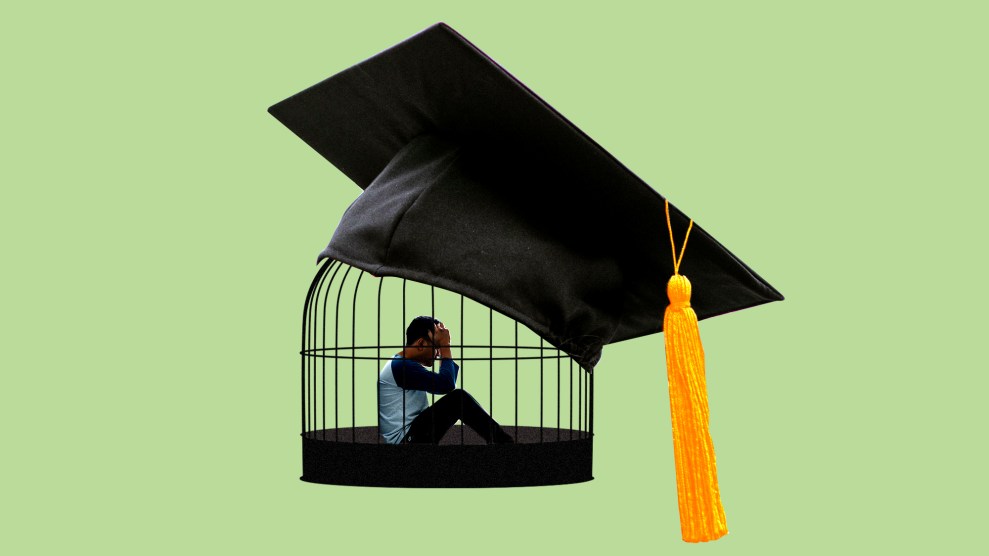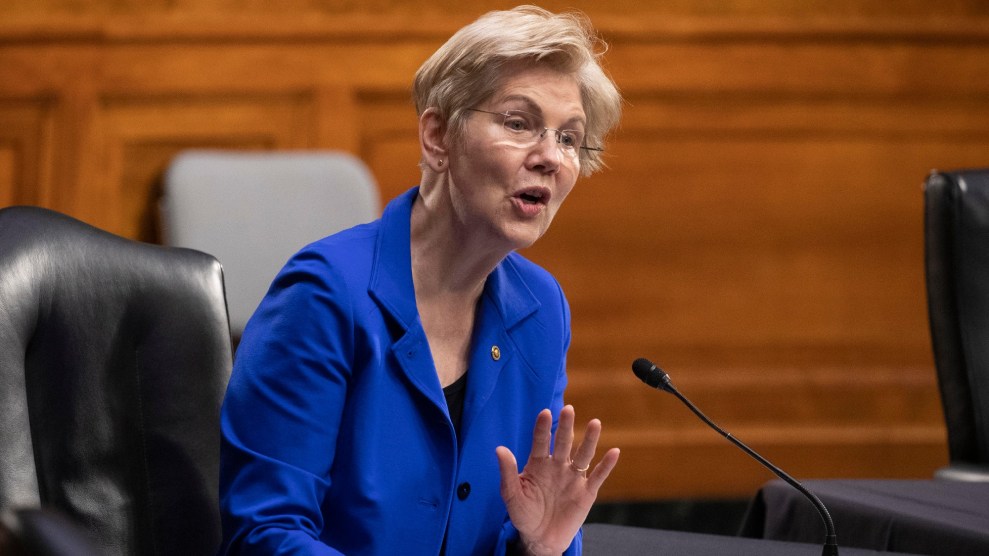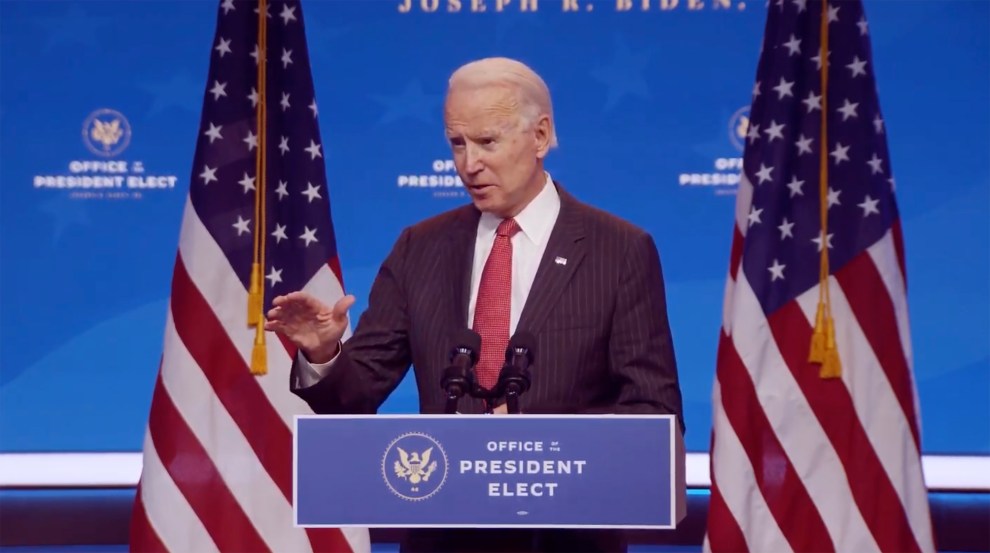
Mother Jones illustration; Unsplash
Joann is a single mother who has been a nurse since 2010. Throughout that time, she had accumulated nearly $140,000 in student loans and paid about $700 each month. The prospect of paying off those loans was daunting, but in October, the Biden administration announced an overhaul of the Public Service Loan Forgiveness program. Joann was certain she would qualify; the program forgives the loans of those who have worked in public service jobs at nonprofits like healthcare facilities or government employers like schools or the military. To be able to participate in the program, borrowers need to have worked for 120 months while continuously making payments every month. And while the PSLF had been plagued with issues since its inception—in 2021 it had a rejection rate of 98 percent—Biden’s October overhaul was designed to fix the problems and broaden the range of eligible borrowers.
But several borrowers who spoke to Mother Jones said that there has been a gap between a well-intentioned makeover and the realities for the people it is designed to help. In Joann’s case, she worked as a nurse while pursuing a master’s degree in nursing. During that time, her loans were put into deferment, which means that her payments were paused on the loan servicer’s assumption that full-time students would not be holding down a full-time job. While ordinarily paused payments would come as a relief, in Joann’s case they meant that many of the years she spent working as a nurse did not count towards loan forgiveness.
Other borrowers had issues with forbearance, a similar status to deferment but one that typically indicates a borrower has missed payments because they couldn’t afford them. In one case, a borrower said that they felt that their servicer hadn’t informed them of cheaper payment plans, which would have made it easier to sustain continuous payments. Some borrowers said that even though their loans were in forbearance, they still made payments, but those payments didn’t count because the Department of Education used forbearance as a proxy for whether borrowers had paid or not.
Put simply, even though the overhaul is said to have led to 22,000 borrowers having their debt immediately forgiven, and to have helped 550,000 borrowers reduce their time on PSLF by an average of 23 payments, the reality for some borrowers is that the changes didn’t go far enough.
“I think this waiver, as much as it helps a lot of people, is leaving so many of us behind,” Joann said. “They should have gone about this better. Because they are helping a portion of people, of course, 100%…but do you know how many we are?”
President Joe Biden has dragged his feet on taking action to address the student loan crisis, where the nation’s 45 million borrowers are saddled with an average debt of $38,000 that often takes decades to repay. During his campaign, he backed a plan to cancel $10,000 worth of student loans per borrower. But activists and some Democratic politicians have claimed that Biden can cancel student debt using an executive order, even as critics insist Biden lacks the legal authority to do so unilaterally. So far, Biden has declined to take action absent legislation from Congress.
One bright spot for activists has been Biden’s reform of the PSLF. Created in 2007 by Congress, the program is designed to forgive the entire student debt of public service workers, who typically earn less than private-sector employees with similar qualifications. In reality, it was easy for borrowers to get caught up in technicalities or red tape. Late payments wouldn’t be counted towards PSLF. Neither would payments that were off by a few cents. And borrowers would only be eligible for PSLF if they had a direct loan from the federal government, leaving out borrowers with Family Federal Education Loans, which are loans that originated in the private sector but were insured by the federal government. Even if FFEL borrowers made payments on those loans, those payments would not count towards the 120 months necessary for loan forgiveness.
“People were confused because they had the wrong loan, they didn’t have a direct loan, or they were in the wrong payment plan,” said Sandy Baum, a senior fellow at the Urban Institute. “But they were making their payments, and they made their payments for ten years, and they thought they should be forgiven.”
The October overhaul of the PSLF made a number of technical changes. It created a waiver so that if borrowers with FFEL loans were to consolidate their loans into direct loans, they would be treated as if their loans had been direct loans for the entire time. The overhaul also got rid of the requirement that previous payments be made on time and for the full amount. Now, if a borrower had some late payments or only had paid a fraction of the amount they owed, or even if they missed that month entirely, that month could still count.
But many borrowers who might have qualified because of the years spent working in public service jobs don’t have loans that conformed to these requirements. The Department of Education calculates which months of public service employment count towards PSLF on the basis of the loan’s repayment status. This means that the months during which a loan is considered as being repaid will count, but the months during which a loan is in forbearance or deferment, won’t. And that can add years to the amount of time before loans can be forgiven.
At least in theory, Joann should have benefited from the waiver. She got a bachelor’s degree and graduated in 2009 with an FFEL loan, but it wasn’t until 2014 that she managed to consolidate her FFEL loan into a direct government loan. Since Joann has worked as a nurse since 2010, the waiver would have subtracted almost four years from the amount of time she needed to wait until her loans were canceled.
But while working full-time in a public service job, Joann also pursued a master’s degree in nursing. “I kept on working full time because I needed to pay rent,” Joann said. “I had a baby at that time, so I couldn’t just go full-time to school.”
While Joann pursued a master’s degree, her loans were placed in deferment by her loan servicer, during which time she made no payments on her loans and no interest accrued. This is standard practice since it is assumed that students would be unable to work full time while attending school. But because Joann was pursuing public service loan forgiveness, the missed payments pushed back the date her loans could be forgiven back by years.
“If this time would count for me…I would be done in 2024 or 2025,” Joann says. “It would be life-changing for me, because $700 dollars a month, it’s just not easy for a single mom.”
Other borrowers had similar issues, but their loans were in forbearance instead of deferment. Borrowers typically enter into forbearance because they are unable to make the monthly payments. And while forbearance pauses those payments, interest continues to accrue each month.
Forbearance isn’t the only option for borrowers who are unable to pay their loans. The Department of Education’s website recommends that borrowers also consider Income-Driven Repayment plans that can reduce the payment amount each month and make it easier to make payments consistently. But despite the Department’s guidance, borrowers are not always informed by their student loan servicers that this plan is an option before they are placed on forbearance. In 2017, the Consumer Finance Protection Bureau sued Navient, one such student loan servicer, alleging that the servicer steered borrowers away from Income-Driven Repayment plans and towards forbearance.
Tammy, a speech-language pathologist who graduated in 2009 with a FFEL loan, consolidated her loans into a direct loan in 2013. Hypothetically, the waiver would have subtracted almost four years from the amount of time she needed to wait until her loans would be canceled. But for most of her time on the FFEL loan, Tammy couldn’t make the payments required by her payment plan, and her loans were placed in forbearance. At the time, Tammy didn’t know that going on an Income-Driven Repayment plan was an option, which would have meant affordable payments she could have made more consistently. It was only after Tammy’s loans were consolidated to direct loans in 2013 that she was able to switch to an Income-Driven Repayment plan.
“Borrowers are not aware of what all their rights are. The student loan system is complicated,” says Persis Yu, policy director at the Student Borrower Protection Center. “I think we need to see a remedy to acknowledge the fact that there has been a longstanding problem of borrowers getting steered into forbearance and deferments.”
The Department of Education did not respond to requests for comment on the program.
Other borrowers who did make payments on their loans had their loans placed into forbearance anyway. Consider Jane, who works at a nonprofit. Jane had both credit card debt and student loans, and when her monthly payments on her credit card debt increased in 2010, she declared chapter 13 bankruptcy, and her student loans were placed on forbearance. Jane was required to set up a payment plan with a trustee, who would take money from her account and use it to pay off her debts. Even though Jane’s loans were recorded as being in forbearance, the trustee still made sure that she continued to make at least partial payments on her student loans.
Although Jane didn’t have complete records regarding her student loans from 2010 and 2013, after 2013, her loans began to be serviced by Sallie Mae. Unlike her previous servicer, Sallie Mae would send her an email every month with a record of how much of her loan had been paid by the trustee, but those payments didn’t count when she attempted to take advantage of the public service waiver. In total, Jane’s bankruptcy took five years off of her progress towards PSLF.
For Jane, the fact that those five years didn’t count was painful. “When the waiver was announced, my coworkers can attest to me physically shaking,” Jane says. The announcement didn’t mention forbearance, but it did say that the Department would count all payments, even if they were late or partial. She remembers thinking, “This could be too good to be true.” As she read the announcement she saw that it “emphatically stated any payment, no matter whether it was full or partial, on time or not” would be counted towards the 120 months.
But that’s not how it worked out. She learned later that because her loans were in forbearance, her payments wouldn’t count. The only exception was for those in the military, whose months of service would count regardless of their loan’s forbearance or deferment status. But borrowers like Jane were out of luck.
“If they’re waving all these other rules which were a lot clearer, why aren’t they waiving that one?” Jane said. “If they’re aware that a lot of us made payments in forbearance, maybe they’ll do something for us.”
The waiver was supposed to eliminate confusion over which student loan types were eligible for PSLF. But even though it expanded eligibility to most loan types including FFEL loans, there was another group of borrowers who were left out: those with joint spousal consolidated loans. Between 1993 and 2006, married couples could combine their student loans into one consolidated loan. This quickly caused problems for those borrowers, particularly in cases where couples divorced. Some borrowers left abusive relationships only to discover they had to maintain contact in order to make joint payments on their loans.
“The joint spousal consolidation loan is this really uniquely terrible product,” said Yu. “Spouses became jointly liable, and they basically have no way out, even in the case where the couple gets divorced.”
This lack of flexibility also made it difficult for those borrowers, like Andrew and his wife, to pursue public service loan forgiveness. Andrew worked for a public school as an English as a second language teacher. His wife worked for a public school district, too. In 2004, the couple had combined their loans into a joint consolidated loan. At the time, the Public Service Loan Forgiveness program didn’t even exist, so the couple had no way of knowing that this decision would have a grave impact on their financial future.
In October, when the Biden administration’s new rule was announced, Andrew saw a message on the website that managed his debt. It suggested the couple convert their private joint loan to a direct loan that could be forgiven. “Not all of your loans are Direct Loans,” the message informed him in a screenshot reviewed by Mother Jones. “If you’re interested in the Public Service Loan Forgiveness Program and/or certain Income-Driven Repayment options, consider consolidating your loans.”
At the time, Andrew wasn’t entirely sure whether the couple’s loan would be covered but that message seemed to suggest that it might. “I got kind of hopeful,” Andrew recalls, “because I would have thought that the website would have recognized [if] my loan didn’t qualify.”
In addition, a second document listed the loan under the code “J” and described loans with that code as types that would be eligible for the waiver. So Andrew and his wife decided to apply to have their loan consolidated into direct loans, the first step towards getting the loans forgiven under PSLF.
In November when he received a notice that the application to consolidate the loans had been denied, Andrew realized that he and his wife had been left out of Biden’s reform. Although Biden’s overhaul allows borrowers who consolidate their loans into direct loans to be treated like they had direct loans the entire time, it didn’t create a new pathway for borrowers with spousal consolidated loans to switch their loans over to direct loans in the first place. Fixing that problem might ultimately require an act of Congress.
“When I got that letter, and when I looked into it, at that moment I just kind of teared up,” Andrew says. “It just felt like this depressing heartbreak, like this is never going to happen.”
In the meantime, Andrew and his wife’s combined $75,000 in student debt continues to have a significant impact on their finances. “Being public school teachers or working for public schools, we don’t make a whole lot of money,” Andrew says. “Our son is 14 years old and going through high school. We could save a lot more money for him going to college, so he wouldn’t have to go through any problems taking out loans.”
For some advocates, all these individual exceptions to accessing the loan forgiveness program emphasize the need for broader action.
“Even when we have this big bold action by the Department on public service loan forgiveness which I think is making tremendous strides, we again see the people who are left out,” says Yu. “This is really why we need widespread debt cancellation because even the best targeting is going to leave out borrowers who we need to be able to capture.”
Images: Davis Sanchez/Unsplash, Yosi Prihantoro/Unsplash













